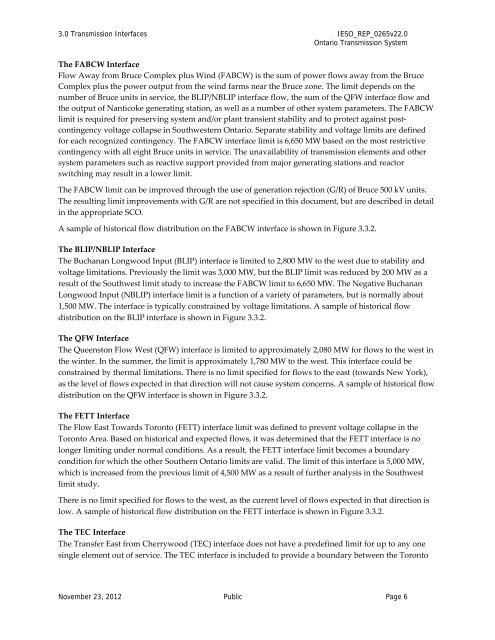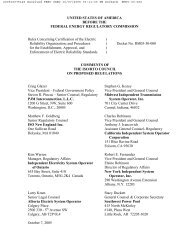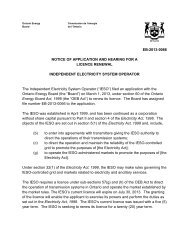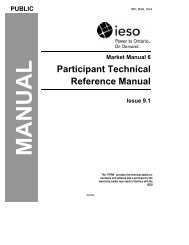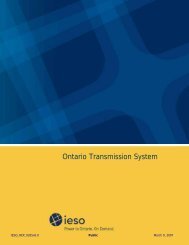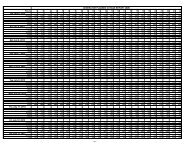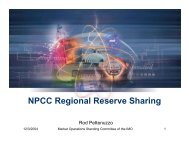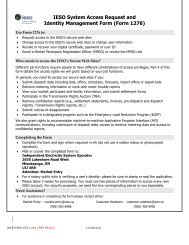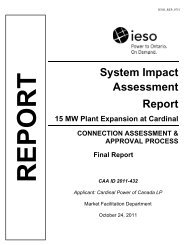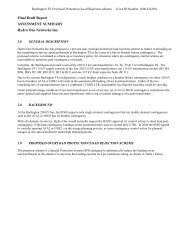Ontario Transmission System - November 2012 - IESO
Ontario Transmission System - November 2012 - IESO
Ontario Transmission System - November 2012 - IESO
You also want an ePaper? Increase the reach of your titles
YUMPU automatically turns print PDFs into web optimized ePapers that Google loves.
3.0 <strong>Transmission</strong> Interfaces <strong>IESO</strong>_REP_0265v22.0<br />
<strong>Ontario</strong> <strong>Transmission</strong> <strong>System</strong><br />
The FABCW Interface<br />
Flow Away from Bruce Complex plus Wind (FABCW) is the sum of power flows away from the Bruce<br />
Complex plus the power output from the wind farms near the Bruce zone. The limit depends on the<br />
number of Bruce units in service, the BLIP/NBLIP interface flow, the sum of the QFW interface flow and<br />
the output of Nanticoke generating station, as well as a number of other system parameters. The FABCW<br />
limit is required for preserving system and/or plant transient stability and to protect against postcontingency<br />
voltage collapse in Southwestern <strong>Ontario</strong>. Separate stability and voltage limits are defined<br />
for each recognized contingency. The FABCW interface limit is 6,650 MW based on the most restrictive<br />
contingency with all eight Bruce units in service. The unavailability of transmission elements and other<br />
system parameters such as reactive support provided from major generating stations and reactor<br />
switching may result in a lower limit.<br />
The FABCW limit can be improved through the use of generation rejection (G/R) of Bruce 500 kV units.<br />
The resulting limit improvements with G/R are not specified in this document, but are described in detail<br />
in the appropriate SCO.<br />
A sample of historical flow distribution on the FABCW interface is shown in Figure 3.3.2.<br />
The BLIP/NBLIP Interface<br />
The Buchanan Longwood Input (BLIP) interface is limited to 2,800 MW to the west due to stability and<br />
voltage limitations. Previously the limit was 3,000 MW, but the BLIP limit was reduced by 200 MW as a<br />
result of the Southwest limit study to increase the FABCW limit to 6,650 MW. The Negative Buchanan<br />
Longwood Input (NBLIP) interface limit is a function of a variety of parameters, but is normally about<br />
1,500 MW. The interface is typically constrained by voltage limitations. A sample of historical flow<br />
distribution on the BLIP interface is shown in Figure 3.3.2.<br />
The QFW Interface<br />
The Queenston Flow West (QFW) interface is limited to approximately 2,080 MW for flows to the west in<br />
the winter. In the summer, the limit is approximately 1,780 MW to the west. This interface could be<br />
constrained by thermal limitations. There is no limit specified for flows to the east (towards New York),<br />
as the level of flows expected in that direction will not cause system concerns. A sample of historical flow<br />
distribution on the QFW interface is shown in Figure 3.3.2.<br />
The FETT Interface<br />
The Flow East Towards Toronto (FETT) interface limit was defined to prevent voltage collapse in the<br />
Toronto Area. Based on historical and expected flows, it was determined that the FETT interface is no<br />
longer limiting under normal conditions. As a result, the FETT interface limit becomes a boundary<br />
condition for which the other Southern <strong>Ontario</strong> limits are valid. The limit of this interface is 5,000 MW,<br />
which is increased from the previous limit of 4,500 MW as a result of further analysis in the Southwest<br />
limit study.<br />
There is no limit specified for flows to the west, as the current level of flows expected in that direction is<br />
low. A sample of historical flow distribution on the FETT interface is shown in Figure 3.3.2.<br />
The TEC Interface<br />
The Transfer East from Cherrywood (TEC) interface does not have a predefined limit for up to any one<br />
single element out of service. The TEC interface is included to provide a boundary between the Toronto<br />
<strong>November</strong> 23, <strong>2012</strong> Public Page 6


